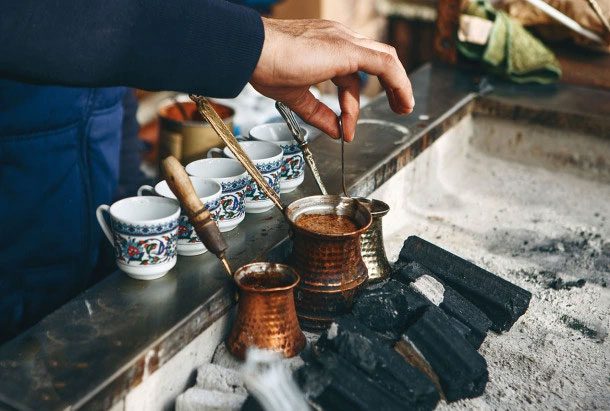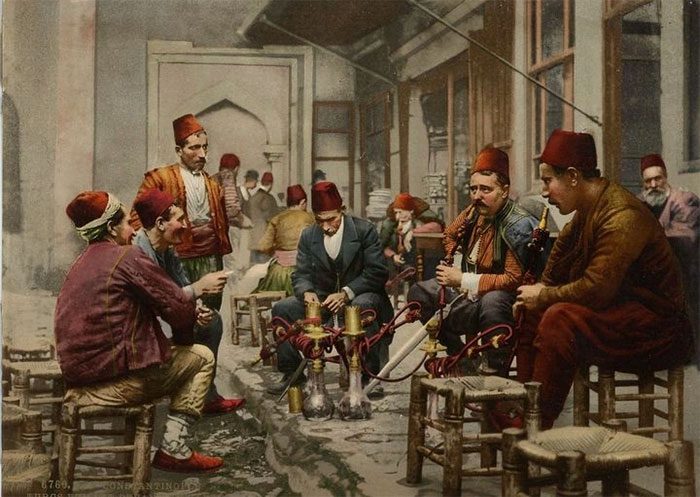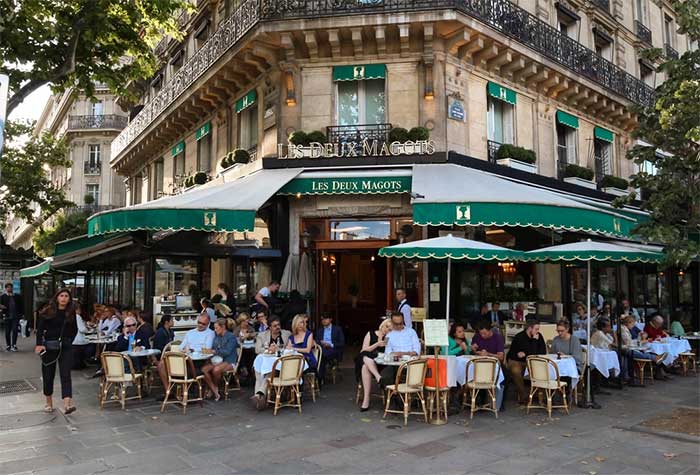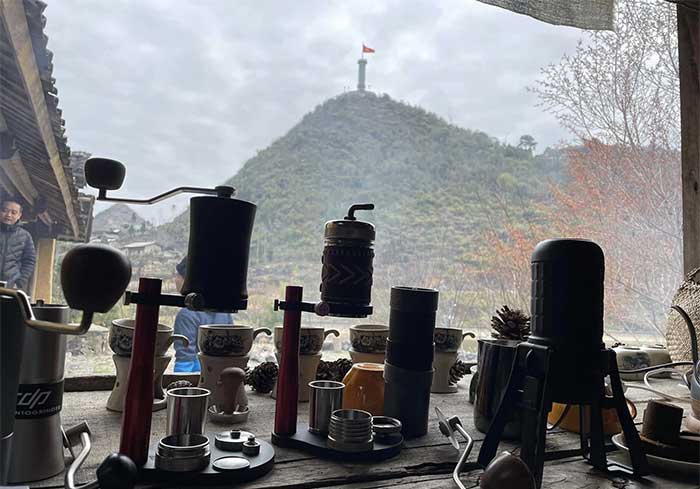Every day, the world consumes about 2.5 billion cups of coffee. To become the popular beverage we know today, it has undergone a long journey, overcoming religious and political barriers.
It has been nearly 2 centuries since coffee arrived in Vietnam, and this energizing drink has quickly gained appreciation over time for both its properties and social characteristics.

Coffee is an essential drink for many people every morning.
People drink coffee while chatting, sharing experiences, during travels, and today it has become an indispensable beverage for many in the morning.
Scientific studies have proven that coffee beans have many health benefits, but in the past, it was at the center of controversies and prohibitions, even sparking uprisings in various countries.
They revolted against the government to allow this beverage to be used in society.
Thus, coffee has undergone a long journey from historical, geographical, to scientific perspectives to become the popular drink we know today.
How did these “cherry beans” (coffee) from Ethiopia spread across the globe to become one of the most consumed products today, and why has it been a source of dread for kings and emperors throughout history, from Saudi Arabia to Europe?
The Origin of Coffee
Legend has it that a shepherd in Abyssinia (present-day Sinai) noticed his sheep became unusually energetic after eating a small type of bean.

Coffee has undergone a long journey to become a popular beverage worldwide.
He decided to pick them to use and became the first to discover the effects of caffeine in the “cherry” (coffee bean) of the Arabica coffee plant.
This man later shared his discovery with the Sufi community (Sinai), where coffee beans were used to brew herbal medicine and quickly gained appreciation for helping them stay awake during prayers.
Despite the beauty of the coffee legend, science has also conducted studies to clarify the origins of this beverage.
One study indicates that Arabica coffee originates from Ethiopia and has been consumed by the ancestors of the people in this region since prehistoric times.
Excavations here revealed that coffee preparations were an integral part of their daily meals.

Coffee beans.
The earliest written evidence related to coffee dates back to the 9th century in a study on the health benefits of this bean.
Later, it was cited by the Persian physician and philosopher Avicenna in his book “Canon of Medicine”, written in the 11th century.
Avicenna described the effects of coffee beans and caffeine on the body, noting that it helps people stay alert and is particularly beneficial for digestion.
In the following centuries, coffee crossed the borders of Eastern countries, especially thanks to pilgrims traveling to the Holy City of Mecca (Saudi Arabia).
They brought it with them to energize their bodies during the long pilgrimage to the Holy Land.
Subsequently, coffee continued to be introduced to Yemen and the rest of the Arab world, making this plant popular and highly valued in society.
As coffee’s popularity spread worldwide, many countries issued bans on its consumption, leading to uprisings. They rose up against the state, demanding the ban be lifted.
The Uprisings
A scientific study reveals that during the Ottoman Empire’s reign over much of the Mediterranean basin and Central Europe, the cultivation and processing of coffee flourished. They established processing plants and roasted beans, and the Ottomans consumed coffee daily.
Through the conquests of the Ottoman Sultan in the 15th century, coffee began to spread to other nations and gained popularity, surpassing the borders of Ethiopia and Yemen.

During the Ottoman Empire, the process of coffee cultivation flourished.
Later, Moka (Yemen) became one of the world’s major coffee production centers at that time.
In Yemen, coffee was mostly produced for commercial purposes, shipped to other countries.
Italian merchants, who specialized in trading spices between the East and Europe, were the first to introduce coffee to Europe.
In the early 17th century, the first coffee beans were brought to Italy, and just a few years later, this beverage began to spread, first among monks and merchants, then to the general public.
The entourage of Pope Clement VIII or among the Islamic nations at that time regarded coffee as a banned substance, declaring it to be a heretical drink.

In the early 17th century, the first coffee beans were brought to Italy. (Illustrative image).
By the mid-17th century, coffee houses began to open in England, serving the intellectual class and free thinkers. They met, drank coffee, and exchanged ideas, giving rise to new political thoughts.
Immediately, King Charles II’s government (United Kingdom) issued a decree to close these places due to concerns over the issues discussed by the public while drinking coffee related to subversive political ideas.
As soon as the ban was enacted, the people of England rebelled everywhere, using slingshots to attack police, forcing the king to quickly lift the regulation. Just 50 years later, England had nearly 2,000 coffee houses spread throughout the territory.
The Spread of Coffee Culture
In France, coffee was introduced into the territory from Egypt (in 1664) specifically in the city of Marseille, where the locals quickly adopted this beverage. By 1681, the first French coffee house was established in the Phocaean city.

A coffee house in France.
It wasn’t until 1669 that coffee was used in the capital, Paris, following a visit from the Ottoman Empire’s envoy named Solimane Aga.
Solimane invited King Louis XIV (who ruled France at the time) to taste this drink that was increasingly spreading across European countries. In 1715, the mayor of Amsterdam (Netherlands) gifted some coffee plants to King Louis XIV when the “coffee treaty” was signed.
A few years later, under the reign of Louis XV, coffee processing and roasting factories were introduced to the island of Réunion, Bourbon, and France quickly established its own coffee plantations for commercial purposes.
Over time, coffee was introduced to South America, Brazil, and Colombia. Due to the slave system at that time, coffee production was ensured; they (the slaves) worked and provided great benefits to plantation owners, but received very little compensation.
Meanwhile, coffee was brought by the British to India (then a British colony) for cultivation and processing to meet the market demands of the British Empire. Unfortunately, all coffee plants here fell ill and died due to their incompatibility with the local climate and soil. They were replaced by tea, which was better suited to local conditions.
In contrast, coffee was officially cultivated by the French in Vietnam starting in 1857, with seeds sourced from Martinique and French Guiana, as they had a similar tropical climate and soil to Vietnam.
Initially, Arabica coffee was tested for cultivation in the northern region, followed by some provinces in central Vietnam. The reason for testing the Arabica variety first was due to its higher value, originally from Ethiopia, suitable for highland and mountainous areas.

Harvesting coffee beans.
During the war period, the coffee drinking culture still expanded among the youth, who enjoyed coffee together while listening to music from composers like Trịnh Công Sơn and Ngô Thụy Miên.
After 1975, coffee returned to the north and quickly became popular across Vietnam from then until now.

Nowadays, many Vietnamese often equip themselves with compact coffee brewing devices, making it easy for them to carry these on their travels (Image: Bao Trung).
Today, all coffee production comes from countries with climates and soils suitable for coffee plants, forming a “coffee belt” around the world.
These are grown in regions such as Central America (Mexico, Guatemala, Nicaragua, Honduras), South America (Colombia, Brazil, Ecuador, Peru), Africa (Ethiopia, Ivory Coast), and in Asia (Vietnam, Indonesia).
In Vietnam, Robusta coffee accounts for the majority of production, which is more bitter than Arabica due to its higher caffeine content.
In 2020, the government and the Vietnam Coffee and Cocoa Association aimed to double the area planted with Arabica coffee, but Robusta coffee still dominates, accounting for 90-95% of the production.
The most popular Arabica variety in Vietnam is Catimor (a hybrid of the Caturra and Timor varieties), known for its high yield and good pest resistance.
Many coffee producers in Vietnam are currently experimenting with higher-quality Arabica varieties, but it will take several more years before they can be widely introduced to the market.


















































